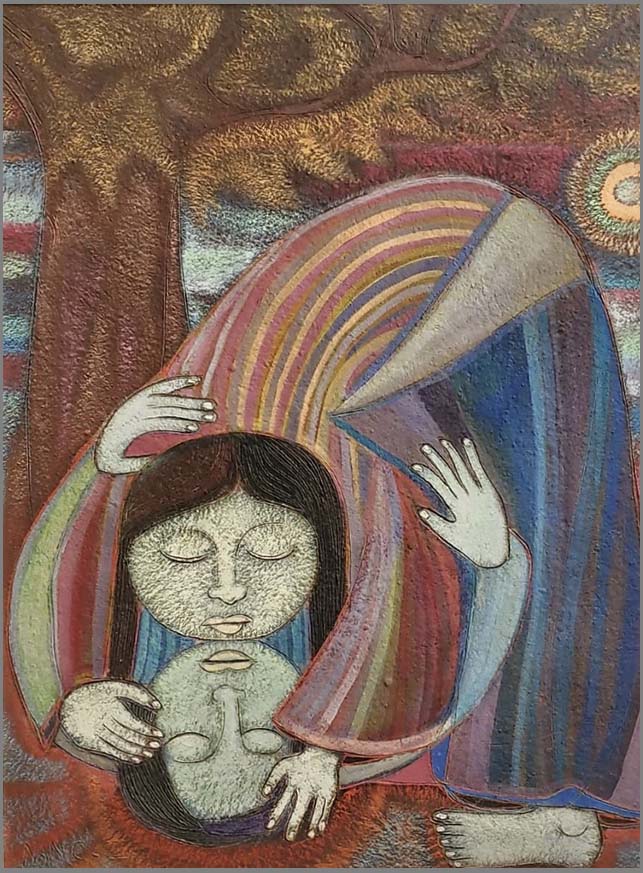

NAN CUZ
"REFLECTION"
OIL ON PANEL, SIGNED
GUATAMALA. C.1965
31.5 X 24.5 INCHES
NAN CUZ 1927-1995 Nan Cuz was born Jan. 4, 1927 in Secoyocte, Municipio de Senahú, in Alta Verapaz, Guatemala of a Q’eqchi Maya mother, Filomena Cuz, and a German father, Hermann Heinemann. She lived with her mother and grandmother in the traditional way, as her father had returned to Germany. In 1934 Heinemann’s German wife, who was unable to have children, traveled to Guatemala to bring Nan back to Germany in order to provide her with a good education. Nan was 7 years old. Although the agreement was that Nan would be returned to her mother when she completed her schooling, World War II and its aftermath prevented this, and Nan was not to see her mother again for 32 years. Is it any wonder that this traumatic event is depicted multiple times in her so-called Madonna and Child paintings? The Madonna is not the Christian Madonna, however, but a cross-cultural Madonna, a Great Mother image, a Mother Earth, displaying a poignancy that brings tears to the eye of the beholder, whether or not one is aware of Nan’s history. Imagine a 7-year-old child who spoke only Q’eqchi Mayan and had never worn shoes arriving in Germany in the era of Nazi power. But Nan brought her own power and a striking intelligence, which enabled her to gradually earn the respect of her peers, although they taunted her for her small size and brown skin, calling her ”little monkey.” Nan was 18 when the war ended. Her father was a professional photographer and taught Nan the craft, but she soon moved on to painting. In 1950 she met and married George Schaefer. They lived in a community on the way to Hamburg and people from all corners of the world passed through, including many artists, writers and philosophers, introducing her to the cultures of the world, which she absorbed and transmuted into her own unique perspective. Nan was beginning to receive artistic recognition in Europe. The scenes and colors of her native land were deeply imbedded in her psyche and appeared to her in dreams and visions, which she expressed in her art. Her work presents us with many aspects of the everyday life of the Maya people, but also gives a strong sense of their spiritual life as well. Above all is the deep and eternal connection with the Earth, nature and all living beings. The second theme that runs through most of Nan’s work is that of Paradise Lost, or rather rediscovered, which comes from deep within the unconscious and indeed taps into the Jungian Universal Unconscious Archetypes, where myth, spiritualism and dream imagery combine to produce visions of a miraculous world that may someday be regained. Landscapes, colors, people, animals and plants buried deep in that 7-year-old psyche emerge seemingly without effort as the past and present merge into a possible future when love of nature and humanity surfaces once again. While the majority of the imagery resonates from the Mayan culture, others arise from Buddhist, Egyptian, Peruvian and other indigenous roots. This can be seen from a German newspaper photo from 1960, titled: The Return of Quetzalcoatl. Unfortunately, the painting is lost. In 1968 Guatemalan First Lady Sara de Méndez Montenegro invited Nan to visit and she was reunited with her mother and extensive Guatemalan family. The exhibition of her work was a huge success and in 1971 she returned to Guatemala with Schaefer and her two children, Thomas and Maya, settling in permanently in Panajachel. Here they created the Galeria de Nan Cuz, one of the first art galleries in Guatemala, which soon became the social, intellectual and artistic center of the town and is a work of art in its own right. In the late ‘70s Nan and Schaefer separated and eventually divorced. She married Horst Koehler in 1987, who shared her deep interest in Tibetan Buddhism, and they traveled the world together until his death in 1995. During this period her work expressed more of the transformational dimension, moving from the magical to the mystical. Although the influence of Klee and Chagall are apparent, Nan soon found her own niche in what one critic called “sophisticated naivety.” Her work speaks to the child in all of us, but contains as well a deeply personal naturalistic mysticism. Figures float among the clouds, the stars, part human, part something else— animal, vegetable, mineral. Their eyes stare out at us, their knowing eyes, Nan’s eyes. They offer us glimpses into another world, magical and beautiful. In May of 2017 an exhibition titled “Magic and Emotion” was held at the ArteCentro Graciela Andrade de Paiz of the Universidad Popular in Guatemala City to honor her work and life. Information from an article in Revue Magazine, May 8, 2017, by Dorothy Kethler. Nan Cuz illustrated book in 1969 titled “The Kingdom of Mescal” subtitled a fairy tale for adults, a copy of the book will be included with the painting.
|